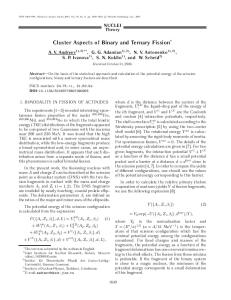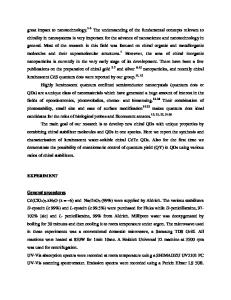Binary and Ternary Mercury Chalcogenide Quantum Dots and Clusters
- PDF / 334,678 Bytes
- 6 Pages / 612 x 792 pts (letter) Page_size
- 54 Downloads / 299 Views
E3.3.1
Binary and Ternary Mercury Chalcogenide Quantum Dots and Clusters Masaru Kuno1,*, Keith A. Higginson2, Syed B. Qadri3, Mohammad Yousuf3, Benjamin L. Davis4 and Hedi Mattoussi1 1 Naval Research Laboratory, Optical Sciences Division, 4555 Overlook Ave. SW Washington, D.C. 20375 2 Current address:Triton Systems Inc. Chelmsford, MA. 3 Naval Research Laboratory, Materials Science Division 4 Naval Research Laboratory, Electronic Science and Technology Division *Corresponding Author: [email protected] ABSTRACT This paper describes the synthesis, characterization and optical properties of binary and ternary mercury chalcogenide quantum dots and clusters. Such materials were made by applying a synthetic strategy involving the simultaneous use of strong Hg(II) coordinating ligands and the explicit phase separation of both metal and chalcogen precursors. High quality QDs and clusters are obtained in this manner with sharply structured absorption and band edge emission covering the visible to near infrared. INTRODUCTION Why mercury chalcogenides? After all a great deal of work has already gone into the development of other II-VI materials such as CdSe. Are there basic issues or intrinsic properties that cannot be addressed, studied or exploited with existing ZnSe, CdS, CdSe and CdTe (or other) quantum dots (QDs)? In short, yes. Bulk mercury chalcogenides are semimetals widely used in infrared sensing applications. Technologically relevant properties of these materials are their ability to form solid solutions with other metal chalcogenides such that the resulting band gap can be tuned over an enormous spectral range. Such tunability can also be explored by making QDs or clusters of mercury chalcogenides wherein simple changes of size or composition can result in dramatic variations of the absorption and emission energy, potentially spanning the visible to the infrared. By contrast, QDs made of semiconductors are limited at the low energy end by their intrinsic bulk band gap, and many well-developed systems, such as CdSe, cannot access the infrared. Tunable absorbing and emitting species covering the near to far infrared have a number of uses including fluorescence tagging applications at 800 nm (and beyond), telecommunications applications at 1.3/1.55 µm and remote sensing/countermeasures applications between 2-5 µm or 7 µm and beyond [1]. In parallel, from a basic science standpoint, we ask how the transition from semi-metallic to semiconducting behavior occurs in mercury chalcogenides as their dimensionality is reduced. For example, when does the inverted Γ6, Γ8 valence band ordering in these materials change to something more typical of zincblende semiconductors? These and other questions motivate our development of the binary/ternary mercury chalcogenide QDs/clusters described in the present study.
E3.3.2
EXPERIMENTAL DETAILS (A) Synthesis The following chemicals were purchased and used without further purification: mercury (II) acetate (HgAc2), bis (2-ethylhexyl)sulfosuccinate (AOT), thioglycerol, trioctyl
Data Loading...











